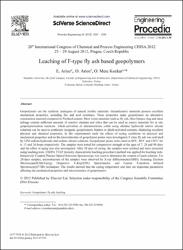| dc.contributor.author | Arıöz, E. | |
| dc.contributor.author | Arıöz, Ömer | |
| dc.contributor.author | Koçkar, Ömer Mete | |
| dc.contributor.editor | Kluson, P | |
| dc.date.accessioned | 2019-10-21T21:11:44Z | |
| dc.date.available | 2019-10-21T21:11:44Z | |
| dc.date.issued | 2012 | |
| dc.identifier.issn | 1877-7058 | |
| dc.identifier.uri | https://dx.doi.org/10.1016/j.proeng.2012.07.503 | |
| dc.identifier.uri | https://hdl.handle.net/11421/21141 | |
| dc.description | 20th International Congress of Chemical and Process Engineering CHISA -- AUG 25-29, 2012 -- Prague, CZECH REPUBLIC | en_US |
| dc.description | WOS: 000392862500114 | en_US |
| dc.description.abstract | Geopolymers are the synthetic analogues of natural zeolitic materials. Geopolymeric materials possess excellent mechanical properties, including fire and acid resistance. These properties make geopolymers an alternative construction material compared to Portland cement. Most waste materials such as fly ash, blast furnace slag and mine tailings contain sufficient amounts of reactive alumina and silica that can be used as source materials for in situ geopolymerisation reactions. Alkali-activation of aluminosilicate solids using alkaline hydroxide and/or silicate solutions can be used to synthesize inorganic geopolymeric binders or alkali-activated cements, displaying excellent physical and chemical properties. In this experimental study the effects of curing conditions on physical and mechanical properties and on the microstructure of geopolymer pastes were investigated. F class fly ash was activated by 12M sodium hydroxide and sodium silicate solutions. Geopolymer pastes were cured at 40 degrees C, 80 degrees C and 120 degrees C for 6, 15 and 24 hours respectively. The samples were tested for compressive strength at the ages of 7, 28 and 90 days and the effect of aging was also investigated. After 28 days of curing, the samples were crushed and were extracted using leaching tests. USEPA TCLP (toxicity characteristic leaching procedure) method was applied for leaching tests. Inductively Coupled Plasma-Optical Emission Spectroscopy was used to determine the content of leach solution. For 28-days samples, microstructure of the samples were observed by X-ray diffractometry(XRD), Scanning Electron Microscope(SEM)/Energy Dispersive X-Ray(EDX) Spectrometer, and Fourier Transform Infrared Spectroscopy(FTIR) techniques. The results showed that the curing temperature and time are important parameters affecting the mechanical properties and microstructure of geopolymers. | en_US |
| dc.description.sponsorship | Anadolu University research [080249] | en_US |
| dc.description.sponsorship | This experimental study was supported by the Anadolu University research project No: 080249. The ICP/OES analysis was carried out at AUBIBAM research centre. | en_US |
| dc.language.iso | eng | en_US |
| dc.publisher | Elsevier Science BV | en_US |
| dc.relation.ispartofseries | Procedia Engineering | |
| dc.relation.isversionof | 10.1016/j.proeng.2012.07.503 | en_US |
| dc.rights | info:eu-repo/semantics/openAccess | en_US |
| dc.subject | Geopolymer | en_US |
| dc.subject | Fly Ash | en_US |
| dc.subject | Leaching | en_US |
| dc.title | Leaching of F-type fly ash based geopolymers | en_US |
| dc.type | conferenceObject | en_US |
| dc.relation.journal | Chisa 2012 | en_US |
| dc.contributor.department | Anadolu Üniversitesi, Mühendislik Fakültesi, Kimya Mühendisliği Bölümü | en_US |
| dc.identifier.volume | 42 | en_US |
| dc.identifier.startpage | 1114 | en_US |
| dc.identifier.endpage | 1120 | en_US |
| dc.relation.publicationcategory | Konferans Öğesi - Uluslararası - Kurum Öğretim Elemanı | en_US |
| dc.contributor.institutionauthor | Koçkar, Ömer Mete | |


















